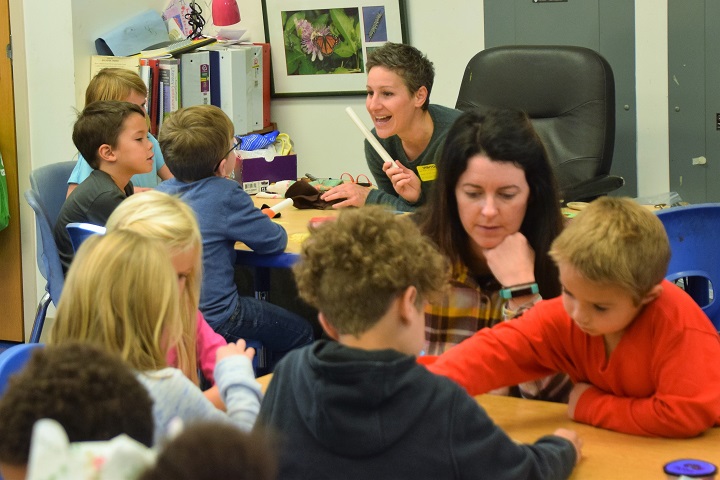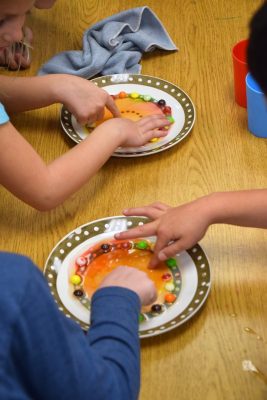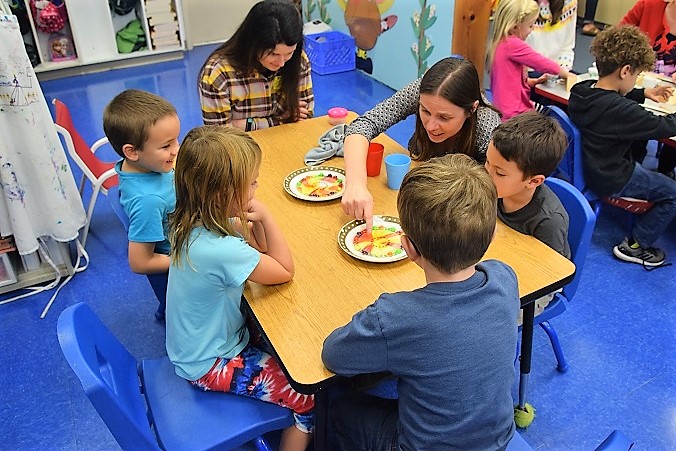
BEAUFORT – Nicola Quick had the full attention of 14 kindergartners in Kimberly Wade’s class at Tiller School, a tuition-free charter school in Carteret County, on a Friday afternoon in late November.
“I’m super excited that we’ve got all these great moms to come and help us do science,” Quick told the students as she introduced the moms who were volunteering to lead experiments as part of Moms Do Science.
Supporter Spotlight
Moms Do Science is a program Quick and two other mothers have been coordinating for a few years as a way to bring hands-on science into the classroom that complements the teacher’s plans.
Mothers of students at Tiller volunteer to lead the grade-appropriate experiments. No science background required.
“Do you know what? We can all do science. Science is everywhere,” Quick, a research scientist at Duke University Marine Lab and mother of two elementary-aged daughters, told the students.
“Today we’re going to do four different experiments to show just cool science is and all the different things that you can do,” she added.
As the groups of three and four students became engaged in the experiments stationed at tables in the classroom and outside, their excitement grew as they learned about static electricity, how warm water versus cold water dissolves candy, floating objects and balance.
Supporter Spotlight
Wade told Coastal Review Online that her kindergarten students loved the experiments, “This was evident by the smiles on their faces.”
Before the program, Quick, Christine Buckel, who is a scientist with the National Oceanic and Atmospheric Administration and has a daughter in second grade, and Jill Pitko, a sculptor who has a daughter in first grade, explained how they launched Moms Do Science at Tiller School
Quick said that three years ago when her and Buckel’s daughters were in kindergarten, the teacher then, like most Tiller teachers, was great at encouraging parents to become involved in the classroom.
“Because we both have a science background, I work at the Duke Marine Lab and Christine works at the NOAA Lab, we thought we could come in and do some science,” Quick said. She said the kindergarten teacher at the time, Janet Sweeney, said they didn’t do much hands-on science because it’s difficult to be hands-on with all the children with just two adults.

“We came up with moms could come in and do science,” which was for a number of reasons, including “The fact that we were women to break down those stereotypes of women doing science and also that we’re moms and that we could help the teachers. … And one thing that a school has got is lots of moms.”
She said the first year, they held one, hourlong event in Sweeney’s class. “Christine and I spent a lot of time talking about how we could do more” and brought in Pitko, who also has a background in engineering.
Buckel said that the general structure is to have multiple, simultaneous experiments. The students are broken up into small groups and they rotate through the experiments and, depending on the number of groups, they’re with an experiment for about 15-20 minutes.
“It’s amazing the amount of science we can conduct in an hour,” Buckel said, adding, Once the experiments start, “you will quickly hear the level of enthusiasm and excitement. It’s very inspiring, I think is the other piece for this too, I think it’s inspiring for the children as well as the moms who are doing the teaching.”
Quick explained that one of the key points of Moms Do Science is that its hands-on, so all the kids get involved.
Pitko added that the students learn by doing, instead of rote learning and trying to absorb, “The kids are much more responsive and take their imagination to their hands and discover by experimenting.”
To come up with the experiments, Quick said they looked at all the teaching standards per grade, which are broken down by main themes like ecosystems, and lots of research.
“One of our main aims was to make science accessible, so we decided we wanted to find experiments that used everyday materials that the kids could relate to, had some context for them,” Quick said.
Using everyday materials not only keeps the cost down and accessible, but also shows that science is everywhere.
Pitko added that the experiments are tailored to the grade level and individual needs of the teacher. They try to meet with the teachers beforehand to try to align the experiments with what the class is working on.
Quick said that last year they visited four grades, some multiple times, and have had Moms Do Science programs four times already this year.
“The students are excited by a number of things: The fact that it’s hands on, the fact that it’s new people in the classroom and the really important thing is that its moms that they know, because that sort of breaks down these stereotypes of who can do science,” Quick said. “I think every parent who has done it has said they’ll come back and do it, sometimes it’s hard to break that stigma that they don’t have to be a science teacher.”
Buckel said that there’s definitely some reluctance from some moms, but, Quick added, there are step-by-step instructions sent out a week before to the moms. “We provide everything, there’s step-by-step, we offer to meet with them before if they want to,” Quick said. Plus, Buckel, Pitko and Quick will be there to help if the moms ask.
“All the descriptions are everyday concepts of science you see all around you,” Pitko added. “They’re in laymen’s terms so that anybody can understand them, read them and relate them to the kids. The kids are just so excited to be doing anything with their hands; they are hearing the science … but they’re doing the discovery on their own.”

The three moms have noticed that through the grades, they see a shift in some students’ confidence in their ability to understand science.
Buckel said that during Moms Do Science programs with fourth and fifth grades, they’re hearing students make comments like, “I’m not good at science.”
The hope, Buckel continued, is that when the students get to fourth and fifth grade who were in kindergarten when they began Moms Do Science, “We don’t hear that anymore.”
Having the moms of their friends helps to show that you don’t have to be a scientist to do science.
Quick added that she’s learned a lot about outreach. As a high-level research scientist, she said she’s realized that Moms do Science is basic science literacy and showing children that everything is possible is way more powerful than going into a room and lecturing.
Wade, who welcomed Moms Do Science to her kindergarten class, explained that it’s important to have children engaged in science at this age.
“It is a way for them to begin using critical thinking skills at a young age and reach conclusions based on their own hypothesis,” she said. “As their teacher, it helps me to connect these experiments to future lessons in math and science. I will also connect it to books I read during the school year. Integration is something I use often as my approach to teaching and this supports my teaching style.”
Wade added that Moms do Science is a wonderful way for mother’s to be involved in the classroom. “It gives parents a perspective on how we teach in the classroom, and it is fun for our students to learn from each other and other adults.”
Kelley Riley, executive director of Tiller School, said that teachers at Tiller have been excited to have moms in the classroom.
“Family engagement is so important to our school and this is truly a unique way to build our students creative confidence and ultimately use these experiences to build their own identities in science whether in our or outside of the classroom,” she said, adding that hands-on, experiential learning is at the heart of our teachers’ instructional planning and delivery.
“Our Moms Do Science group has taken this to heart and work hard to first collaborate with our teachers to plan and then deliver science exploration and experiments to our students,” she said. “They bring new and fresh ideas that enrich our students’ learning experiences. This is a partnership that fosters an opportunity for our parents to be involved, for our students to learn from one another and learn from women that are passionate about science, creativity and problem-solving.
“Our ultimate goal is to share learning experiences with our students that are an authentic means of them seeing that being a ‘lifelong learner’ means something to our educators, our families and our school. It is our hope that their lessons and activities spark interest in science topics and fuels our students’ curiosity about the world around them,” Riley said.
The three Moms Do Science organizers hope to create a science packet for teachers that any volunteer could lead because they didn’t want the program to be an extra burden for teachers.
To learn more visit https://www.tillerschool.org/moms-do-science







